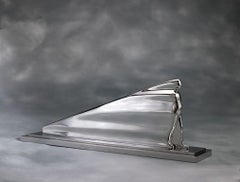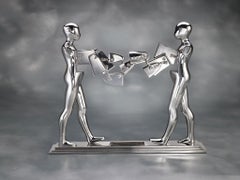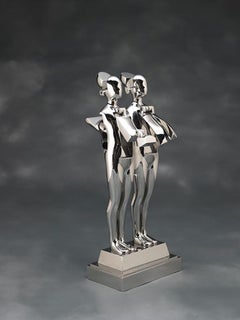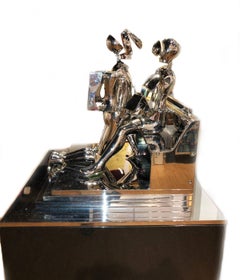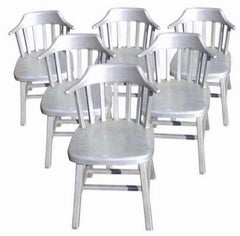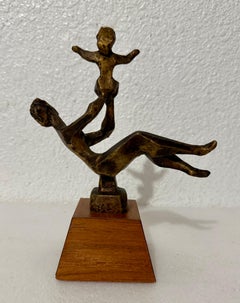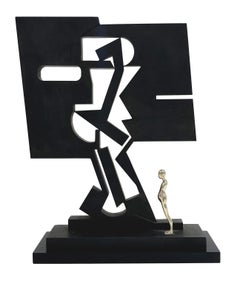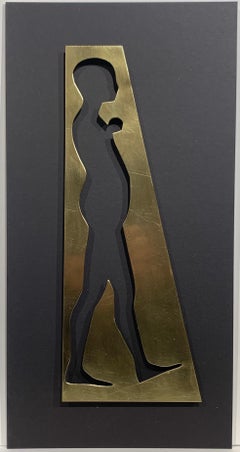Ernest Trova Figurative Sculptures
American, 1927-2009
In the early 1960s, St. Louis Sculptor Ernest Trova—who was entirely self-taught—began developing his pivotal theme of Falling Man, a stark and startling image that combines references to classical sculpture with an industrial aesthetic. In his Profile Canto series, Falling Man—depicted as an androgynous, mechanical figure—is folded and segmented as to be nearly undetectable amid the various geometric forms that comprise these works.to
1
1
2
Overall Width
to
Overall Height
to
3
1
1
2
1
1
1
1
4
4
11
125
100
94
88
4
Artist: Ernest Trova
Flowing Man
By Ernest Trova
Located in Boca Raton, FL
Edition 37/99
Category
21st Century and Contemporary Contemporary Ernest Trova Figurative Sculptures
Materials
Stainless Steel
Double Walking Figure
By Ernest Trova
Located in Boca Raton, FL
rnest Trova was an artist whose signature creation, a gleaming humanoid known as “Falling Man,” appeared in a series of sculptures and paintings and became a symbol of an imperfect humanity hurtling into the future. Mr. Trova was largely known as a sculptor, but his “Falling Man,” a standard of Pop Art, began life as a painted figure, taking shape on his easel in the early 1960s. Faceless, armless, with a hint of a belly and, its name notwithstanding, of indeterminate sex, the figure struck a variety of poses, sometimes juxtaposed with other like figures, sometimes with mechanical appendages.
In October 1963 his one-man show, “Falling Man Paintings,” was the inaugural exhibition of the Pace Gallery on West 57th Street in Manhattan; it sold out, with the works purchased by the Museum of Modern Art, the Whitney Museum, the architect Philip Johnson and others. In three dimensions, the “Falling Man” figure was made from different materials over the years — nickel and chrome-plated bronze, enamel on aluminum, stainless steel — and often, like the Oscar statuette, was polished to an industrial sheen. It was clearly a space age creation, a forerunner of C3PO, the golden robot in “Star Wars.”
“He found the space age both inspiring and dehumanizing,” Arne Glimcher, who founded the Pace Gallery, now PaceWildenstein, said in an interview on Friday. By the end of the 1960s, “Falling Man” had become Mr. Trova’s trademark, provoking Hilton Kramer, the art critic of The New York Times, to write that Mr. Trova had subjected his favorite figure “to almost as many variations as the Kama Sutra describes for the act of love.”
Ernest Tino Trova Jr. was born in St. Louis on Feb. 19, 1927. Shortly after his high school graduation his father, an industrial tool designer and inventor, died, and young Ernie, as he was known, went to work, most significantly as a window dresser for a department store. His early paintings were in the Abstract Expressionist mode, but his attentiveness to the mannequins had an influence on his art. Through the 1970s and 1980s he continued with “Falling Man,” though he also became interested in formalized, almost mechanical-seeming landscapes, and the figures began to appear, reduced in size, within the context of abstractly rendered gardens.
A self-taught artist with an impish wit and an eccentric turn of mind, Mr. Trova craved the recognition that was available to artists only in New York City, but he never visited for more than a week at a time and made almost no friends among New York artists. He did befriend Ezra Pound. As a fevered fan of Julio Iglesias, he went to the singer’s concerts all over the United States. “Ernie had a fabulous fantasy life,” Richard Solomon, the president of Pace Prints, the publishing arm of PaceWildenstein, said in an interview. “He had a persona he used to hide behind that he called ‘Junior Person.’ He was a wonderful man, but an oddball to beat the band.”
Mr. Trova left the Pace Gallery in the mid-1980s and signed with an inexperienced dealer in St. Louis. His profile went into decline, except in his hometown, where his donation of many of his works helped create the Laumeier Sculpture Park. He continued to work until shortly before his death. Most recently he was making collages using magazine...
Category
20th Century Ernest Trova Figurative Sculptures
Materials
Stainless Steel
Double Flapman
By Ernest Trova
Located in Boca Raton, FL
AP 2
Ernest Trova was an artist whose signature creation, a gleaming humanoid known as “Falling Man,” appeared in a series of sculptures and paintings and became a symbol of an imperfect humanity hurtling into the future. Mr. Trova was largely known as a sculptor, but his “Falling Man,” a standard of Pop Art, began life as a painted figure, taking shape on his easel in the early 1960s. Faceless, armless, with a hint of a belly and, its name notwithstanding, of indeterminate sex, the figure struck a variety of poses, sometimes juxtaposed with other like figures, sometimes with mechanical appendages.
In October 1963 his one-man show, “Falling Man Paintings,” was the inaugural exhibition of the Pace Gallery on West 57th Street in Manhattan; it sold out, with the works purchased by the Museum of Modern Art, the Whitney Museum, the architect Philip Johnson and others. In three dimensions, the “Falling Man” figure was made from different materials over the years — nickel and chrome-plated bronze, enamel on aluminum, stainless steel — and often, like the Oscar statuette, was polished to an industrial sheen. It was clearly a space age creation, a forerunner of C3PO, the golden robot in “Star Wars.”
“He found the space age both inspiring and dehumanizing,” Arne Glimcher, who founded the Pace Gallery, now PaceWildenstein, said in an interview on Friday. By the end of the 1960s, “Falling Man” had become Mr. Trova’s trademark, provoking Hilton Kramer, the art critic of The New York Times, to write that Mr. Trova had subjected his favorite figure “to almost as many variations as the Kama Sutra describes for the act of love.”
Ernest Tino Trova Jr. was born in St. Louis on Feb. 19, 1927. Shortly after his high school graduation his father, an industrial tool designer and inventor, died, and young Ernie, as he was known, went to work, most significantly as a window dresser for a department store. His early paintings were in the Abstract Expressionist mode, but his attentiveness to the mannequins had an influence on his art. Through the 1970s and 1980s he continued with “Falling Man,” though he also became interested in formalized, almost mechanical-seeming landscapes, and the figures began to appear, reduced in size, within the context of abstractly rendered gardens.
A self-taught artist with an impish wit and an eccentric turn of mind, Mr. Trova craved the recognition that was available to artists only in New York City, but he never visited for more than a week at a time and made almost no friends among New York artists. He did befriend Ezra Pound. As a fevered fan of Julio Iglesias...
Category
20th Century Contemporary Ernest Trova Figurative Sculptures
Materials
Stainless Steel
The Encounter
By Ernest Trova
Located in Missouri, MO
Ernest Trova
"The Encounter" 1994
Chrome Plated Steel
Approx 24 x 26 x 24 inches
Edition 1/8
Known for his Falling Man series in abstract figural sculpture, he created hard-edge ima...
Category
1990s American Modern Ernest Trova Figurative Sculptures
Materials
Stainless Steel
Price Upon Request
Related Items
Six Vintage Stainless Steel Sculptural Dining Chairs Sculpture Mid-Century Set 6
Located in New York, NY
Six Vintage Stainless Steel Sculptural Dining Chairs Sculpture Mid-Century Set
Kings and Queens could feats on these sculptures, this stunning set of six dining chairs. They are art...
Category
1950s Modern Ernest Trova Figurative Sculptures
Materials
Stainless Steel
$10,000
H 30 in W 19 in D 19 in
Chaim Gross Mid Century Mod Bronze Sculpture Mother and Baby Playing WPA Artist
By Chaim Gross
Located in Surfside, FL
Chaim Gross (American, 1904-1991)
Cast bronze sculpture
Caring (or Mother and Child)
signed
Mounted on wooden plinth
Featuring a mother raising her child up in superb high relied i...
Category
Mid-20th Century American Modern Ernest Trova Figurative Sculptures
Materials
Bronze
$2,400
H 9 in W 7.5 in D 3.5 in
WATER RIFLE - Modern obiect sculpture made of steel and fabric
By Sylwia Jakubowska-Szycik
Located in Salzburg, AT
Sylwia Jakubowska-Szycik is professor at the Academy of Fine Arts at the Faculty of Sculpture and Intermedia in Gdańsk, she conducts classes in the f...
Category
2010s Contemporary Ernest Trova Figurative Sculptures
Materials
Stainless Steel
$2,015
H 33.08 in W 9.06 in D 1.58 in
"The Party" Sculpture 20.5" x 13" x 8" inch Ed. of 333 by Huang Yulong
By Huang Yulong
Located in Culver City, CA
"The Party" Sculpture 20.5" x 13" x 8" inch Ed. of 333 by Huang Yulong
The Party/党派
2018 was special. That period reminded me of the friends I faced when I was dancing in college. S...
Category
21st Century and Contemporary Contemporary Ernest Trova Figurative Sculptures
Materials
Stainless Steel
$3,500
H 20.5 in W 13 in D 8 in
Harmony, 20th century bronze & green marble base, nude man and woman with lyre
By Max Kalish
Located in Beachwood, OH
Max Kalish (American, 1891-1945)
Harmony, c. 1930
Bronze with green marble base
Incised signature on right upper side of base
14 x 9 x 5 inches, excluding base
17 x 10 x 8 inches, including base
Born in Poland March 1, 1891, figurative sculptor Max Kalish came to the United States in 1894, his family settling in Ohio. A talented youth, Kalish enrolled at the Cleveland Institute of Art as a fifteen-year-old, receiving a first-place award for modeling the figure during studies with Herman Matzen. Kalish went to New York City following graduation, studying with Isidore Konti...
Category
1930s American Modern Ernest Trova Figurative Sculptures
Materials
Marble, Bronze
$10,450
H 17 in W 10 in D 8 in
Head IV
By Tom Binger
Located in Kansas City, MO
Tom Binger
"Head IV"
Medium: Mixed Media
Year: 2018, Signed
Size: 14.5 x 10.25 x 2 inches
Tom Binger finds it interesting that during a time in which the internet is quickly becomin...
Category
2010s American Modern Ernest Trova Figurative Sculptures
Materials
Metal
Modern Pop Art Dita Mel Ramos Stainless Steel Nude Sculpture
By Mel Ramos
Located in Zug, CH
MEL RAMOS (1935-2018)
Dita
2017
Cast and polished stainless steel
58 x 33 x 26 cm
22.83 x 12.99 x 10.24 inches
Number 29 of 60,
Edition of 60 + 6 A.P.
Cast signature and number on b...
Category
20th Century Pop Art Ernest Trova Figurative Sculptures
Materials
Stainless Steel
$24,007 Sale Price
22% Off
H 22.84 in W 13 in D 10.24 in
Mark Kostabi - Divine Embrace - Bronze Sculpture
By Mark Kostabi
Located in Winterswijk, NL
Mark Kostabi - Divine Embrace - Bronze sculpture
Divine Embrace is a unique bronze sculpture by renowned artist Mark Kostabi, featuring two faceless figures in an intimate embrace...
Category
21st Century and Contemporary American Modern Ernest Trova Figurative Sculptures
Materials
Bronze
"Zofar" Boaz Vaadia, Human Body, Bronze and Stone, Anthropomorphic Sculpture
By Boaz Vaadia
Located in New York, NY
Boaz Vaadia
Zofar, 1997
Bronze, bluestone, and boulder
Overall 20 x 29 x 27 inches
From the edition of 7
Provenance
Elaine Baker Gallery, Boca Raton, Florida
Boaz Vaadia is the in...
Category
1990s American Modern Ernest Trova Figurative Sculptures
Materials
Bluestone, Stone, Bronze
$40,000
H 20 in W 29 in D 27 in
Nude Walking, Early 20th Century Bronze Sculpture, Cleveland School Artist
By Max Kalish
Located in Beachwood, OH
Max Kalish (American, 1891-1945)
Nude Walking, 1930
Bronze
Signed and dated on base
17 x 9 x 4 inches
Born in Poland March 1, 1891, figurative sculptor Max Kalish came to the United States in 1894, his family settling in Ohio. A talented youth, Kalish enrolled at the Cleveland Institute of Art as a fifteen-year-old, receiving a first-place award for modeling the figure during studies with Herman Matzen. Kalish went to New York City following graduation, studying with Isidore Konti and Herbert Adams...
Category
1930s American Modern Ernest Trova Figurative Sculptures
Materials
Bronze
$8,125
H 17 in W 9 in D 4 in
Vintage Arthur Court Aluminum Sculpture Cast Bouquet Flowers, Ladybug Home Decor
Located in Surfside, FL
A designer decor bouquet of aluminum floral forms by Arthur Court Designs (California). Produced 1989. Includes: four (4) aluminum flowers on stems; and...
Category
1980s American Modern Ernest Trova Figurative Sculptures
Materials
Metal
Arthur CourtVintage Arthur Court Aluminum Sculpture Cast Bouquet Flowers, Ladybug Home Decor, c.1989
$1,500
H 21 in W 10 in D 3 in
"Skulls Alphabet Nr. D" Bronze and Steel Sculpture 1/1 by Sergii Shaulis
By Sergii Shaulis
Located in Culver City, CA
"Skulls Alphabet Nr. D" Bronze and Steel Sculpture 1/1 by Sergii Shaulis
9.5" x 6" x 8'' inch
Weight: 14 lbs
SKULLS "ALPHABET" series:
The project i...
Category
21st Century and Contemporary Contemporary Ernest Trova Figurative Sculptures
Materials
Bronze, Stainless Steel
$4,200
H 9.5 in W 6 in D 8 in
Previously Available Items
FALLING MAN GOX (SCULPTURE)
By Ernest Trova
Located in Aventura, FL
Bronze and steel sculpture with black patination, on black acrylic base. Etched artist signature with title, date and edition to base underside. Published by Pace Editions. From t...
Category
1970s Pop Art Ernest Trova Figurative Sculptures
Materials
Bronze, Steel
Walking Man with Disc
By Ernest Trova
Located in Wilton Manors, FL
Beautiful figural sculpture by American artist, Ernest Tino Trova (1927-2009). Walking Man with Disc (working study), 1966. Brass sheet with cut-out figure in profile, sheet measures...
Category
Mid-20th Century Abstract Ernest Trova Figurative Sculptures
Materials
Brass
TRISTAN GOX (SCULPTURE)
By Ernest Trova
Located in Aventura, FL
Steel and bronze sculpture. Inscribed signature and numbered. Artwork is in excellent condition. Certificate of authenticity included. Edition of 125. All reasonable offers will be...
Category
1970s Pop Art Ernest Trova Figurative Sculptures
Materials
Bronze, Steel
Ernest Trova figurative sculptures for sale on 1stDibs.
Find a wide variety of authentic Ernest Trova figurative sculptures available for sale on 1stDibs. You can also browse by medium to find art by Ernest Trova in metal, stainless steel, brass and more. Much of the original work by this artist or collective was created during the 20th century and is mostly associated with the contemporary style. Not every interior allows for large Ernest Trova figurative sculptures, so small editions measuring 9 inches across are available. Customers who are interested in this artist might also find the work of Anthony Quinn, Norma Minkowitz, and Kathleen Vance. Ernest Trova figurative sculptures prices can differ depending upon medium, time period and other attributes. On 1stDibs, the price for these items starts at $1,200 and tops out at $55,000, while the average work can sell for $18,500.
Artists Similar to Ernest Trova
Bernard Rives
